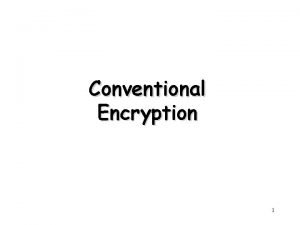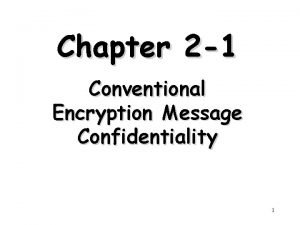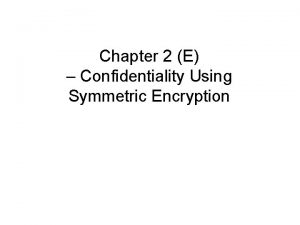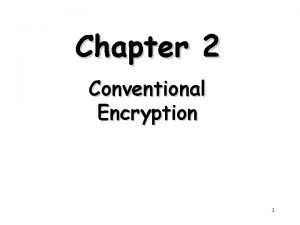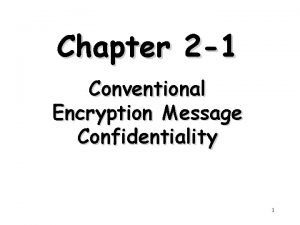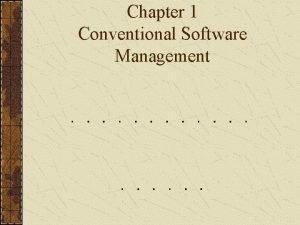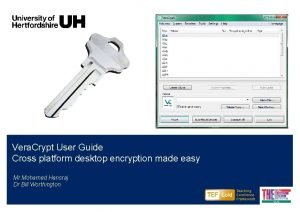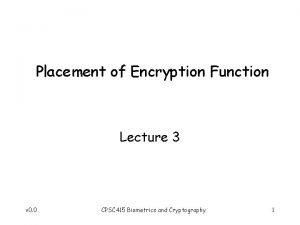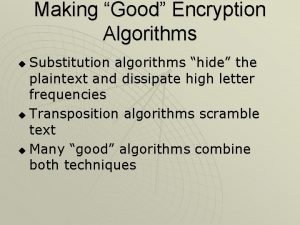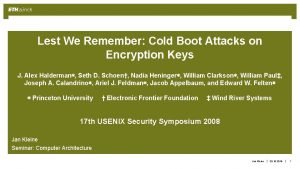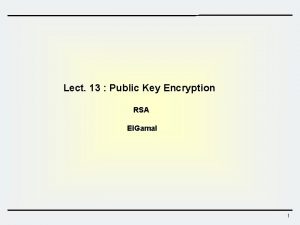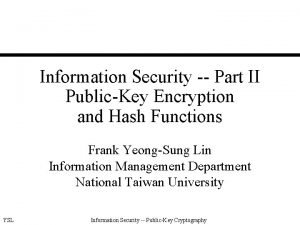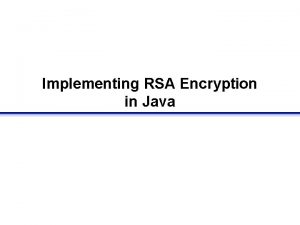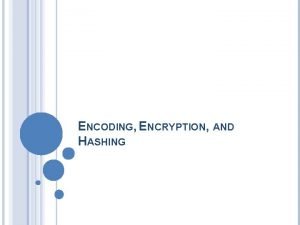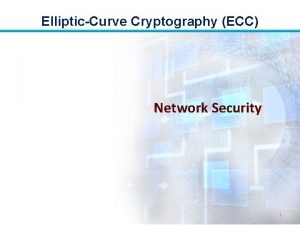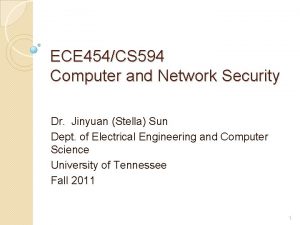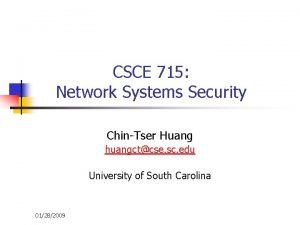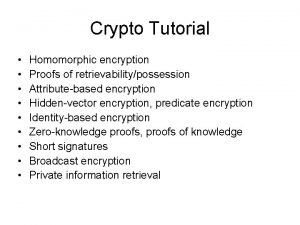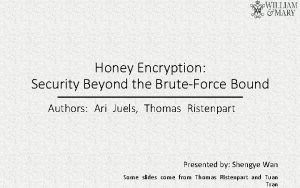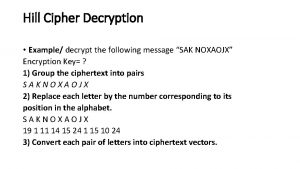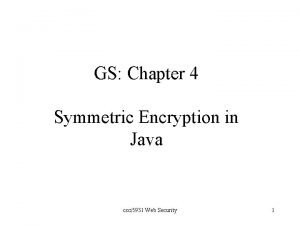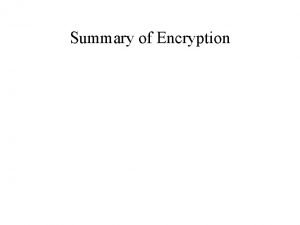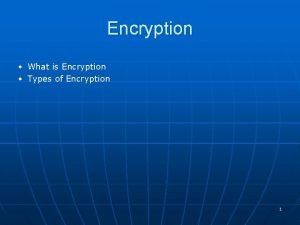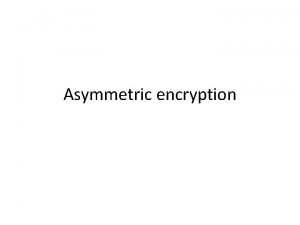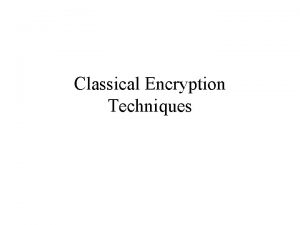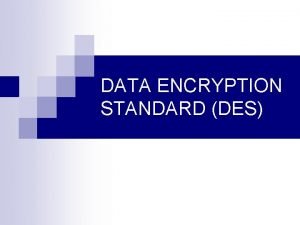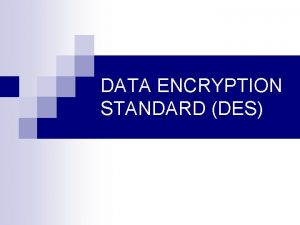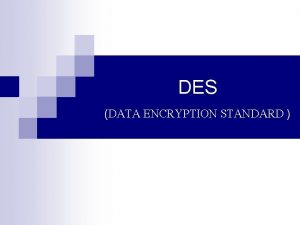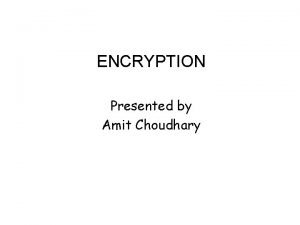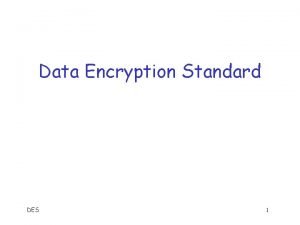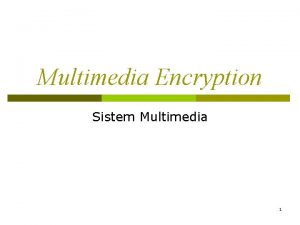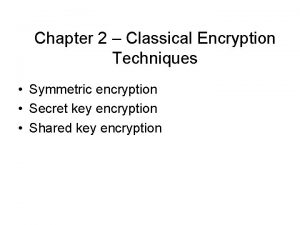Conventional Encryption 1 Outline Conventional Encryption Principles Conventional





























- Slides: 29

Conventional Encryption 1

Outline • • • Conventional Encryption Principles Conventional Encryption Algorithms Cipher Block Modes of Operation Location of Encryption Devices Key Distribution 2

Symmetric Encryption • A. k. a. conventional / secret-key / single-key • Sender and recipient share a common key • All classical encryption algorithms are secretkey-based • Was the only type prior to the invention of public-key in 1970’s – Why? • By far most widely used 3

Conventional Encryption Principles • An encryption scheme has five ingredients: – – – Plaintext Encryption algorithm Secret key Ciphertext Decryption algorithm • Security depends on the secrecy of the key, not the secrecy of the algorithm – Why? 4

Conventional Encryption Principles 5

Requirements • Two requirements for secure use of symmetric encryption: – A strong encryption algorithm – A secret key known only to sender and receiver • Mathematically we have: Y = EK(X) X = DK(Y) • Assume encryption algorithm is known • Implies a secure channel to distribute key 6

Cryptography • Characterize cryptographic systems by: – Type of encryption operations used • Substitution / Transposition / Product – Number of keys used • Single-key or secret / two-key or public – Way in which plaintext is processed • Block / stream 7

More Definitions • Unconditional security – No matter how much computer power or time is available, the cipher cannot be broken since the ciphertext provides insufficient information to uniquely determine the corresponding plaintext • Computational security – Given limited computing resources (e. g. time needed for calculations is greater than the age of universe), the cipher cannot be broken – Security of a key/password? 8

Confusion and Diffusion • Cipher needs to completely obscure statistical properties of the original message – A one-time pad does this • More practically, Shannon suggested combining S & P elements to obtain: – Diffusion • Dissipates statistical structure of plaintext over bulk of ciphertext – Confusion • Makes relationship between ciphertext and key as complex as possible 9

Brute Force Search (Exhaustive Key Search) • Always possible to simply try every key • Most basic attack, proportional to key size • Assume either know / recognize plaintext Key Size (bits) Number of Alternative Keys Time required at 1 decryption/µs 106 decryptions/µs 32 232 = 4. 3 109 231 µs = 35. 8 minutes 2. 15 milliseconds 56 256 = 7. 2 1016 255 µs = 1142 years 10. 01 hours 128 2128 = 3. 4 1038 2127 µs = 5. 4 1024 years 5. 4 1018 years 168 2168 = 3. 7 1050 2167 µs = 5. 9 1036 years 5. 9 1030 years 26! = 4 1026 2 1026 µs = 6. 4 1012 years 26 letters (permutation) 6. 4 106 years 10

Conventional Encryption Algorithms • Data Encryption Standard (DES) – The most widely used encryption scheme – The algorithm is reffered to as the Data Encryption Algorithm (DEA) – DES is a block cipher – The plaintext is processed in 64 -bit blocks – The key is 56 -bits in length in the original version 11

12

13

DES • Mathematically, the overall processing at each iteration: – Li = Ri-1 – Ri = Li-1 F(Ri-1, Ki) • Concerns about: – The algorithm and the key length (56 -bits) 14

Time to break a code (106 decryptions/µs) 15

Strength of DES – Key Size • 56 -bit keys have 256 = 7. 2 x 1016 values – Brute force search looks hard • Recent advances have shown possibilities – In 1997 on the Internet in a few months – In 1998 on dedicated h/w (EFF) in a few days – In 1999 above combined in 22 hrs! • Still must be able to recognize plaintext 16

Alternatives to DES • A replacement for DES was needed – Have theoretical attacks that can break it – have demonstrated exhaustive key search attacks • A strengthened DES – Triple-DEA (Triple-DES) 17

Triple DEA • Use three keys and three executions of the DES algorithm (encrypt-decryptencrypt) C = EK 3[DK 2[EK 1[P]]] • • C = ciphertext P = Plaintext EK[X] = encryption of X using key K DK[Y] = decryption of Y using key K • Effective key length of 168 bits (3 x 56) 18

Triple DEA 19

Alternatives to DES • Triple-DES – Slow • Use small blocks • AES Cipher – Rijndael – Designed by Joan. Daemen and Vincent Rijmen in Belgium – Has 128/192/256 -bit keys, 128 -bit data – An iterative rather than feistel cipher • Processes data as block of 4 columns of 4 bytes • Operates on entire data block in every round 20

Block vs. Stream Ciphers • Block ciphers – Process messages in blocks, each of which is then en/decrypted – Like a substitution on very big characters • 64 -bits or more – Need a table of 2^64 entries for a 64 -bit block • Instead, create from smaller building blocks – Using the idea of a product cipher – Many current ciphers are block ciphers • A wide range of applications • Stream ciphers – Process messages a bit or byte at a time when en/decrypting 21

Other Symmetric Block Ciphers • International Data Encryption Algorithm (IDEA) – 128 -bit key – Used in PGP • Blowfish – Easy to implement – High execution speed – Run in less than 5 K of memory 22

Other Symmetric Block Ciphers • RC 5 – Suitable for hardware and software – Fast, simple – Adaptable to processors of different word lengths – Variable number of rounds – Variable-length key – Low memory requirement – High security – Data-dependent rotations • Cast-128 – Key size from 40 to 128 bits – The round function differs from round to round 23

Location of Encryption Device • Link encryption: – A lot of encryption devices – High level of security – Decrypt each packet at every switch • End-to-end encryption – The source encrypts and the receiver decrypts – Payload encrypted – Header in the clear • High Security – Both link and end-to-end encryption are needed 24

25

Key Distribution 1. Physical delivery § § A key could be selected by A and physically delivered to B. A third party could select the key and physically deliver it to A and B. 2. Network transfer § § § If A and B have previously used a key, one party could transmit the new key to the other, encrypted using the old key. If A and B each has an encrypted connection to a third party C, C could deliver a key on the encrypted links to A and B. Diffie-Hellman key exchange 26

Session and Permanent Key • Session key: – Data encrypted with a one-time session key – At the conclusion of the session, the key is destroyed • Permanent key: – Used between entities for the purpose of distributing session keys 27

28

Recommended Reading • Scneier, B. Applied Cryptography, New York: Wiley, 1996 • Mel, H. X. Baker, D. Cryptography Decrypted. Addison Wesley, 2001 29
 Conventional encryption model
Conventional encryption model Conventional encryption and message confidentiality
Conventional encryption and message confidentiality Confidentiality using conventional encryption
Confidentiality using conventional encryption What is conventional encryption
What is conventional encryption Conventional encryption model
Conventional encryption model Paragraph sandwich example
Paragraph sandwich example Late design breakage
Late design breakage Conventional software
Conventional software Vera desktop
Vera desktop Homomorphic encryption standard
Homomorphic encryption standard Symmetric encryption advantages and disadvantages
Symmetric encryption advantages and disadvantages Explain about the placement of encryption function
Explain about the placement of encryption function Exchange hosted encryption
Exchange hosted encryption Making good encryption algorithms
Making good encryption algorithms Lest we remember: cold boot attacks on encryption keys
Lest we remember: cold boot attacks on encryption keys Rsa el
Rsa el Public key encryption
Public key encryption Java rsa encryption example
Java rsa encryption example Encoding and encryption
Encoding and encryption Encryption decrypti
Encryption decrypti Crc encryption
Crc encryption Encryption
Encryption Homomorphic encryption tutorial
Homomorphic encryption tutorial Encryption wizard
Encryption wizard Encryption
Encryption Ibm cloud object storage on premise
Ibm cloud object storage on premise Decrypt
Decrypt Homomorphic encryption tutorial
Homomorphic encryption tutorial Hill cipher example encryption decryption
Hill cipher example encryption decryption Symmetric encryption java
Symmetric encryption java
